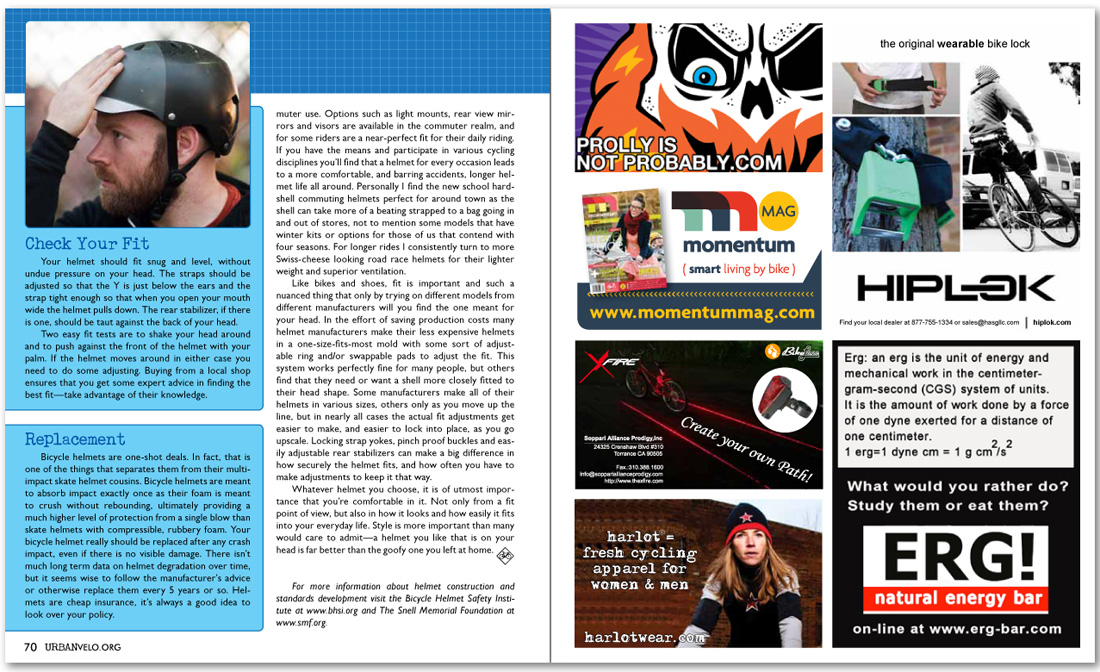


muter use. Options such as light mounts, rear view mirrors and visors are available in the commuter realm, and for some riders are a near-perfect fit for their daily riding. If you have the means and participate in various cycling disciplines you’ll find that a helmet for every occasion leads to a more comfortable, and barring accidents, longer helmet life all around. Personally I find the new school hardshell commuting helmets perfect for around town as the shell can take more of a beating strapped to a bag going in and out of stores, not to mention some models that have winter kits or options for those of us that contend with four seasons. For longer rides I consistently turn to more Swiss-cheese looking road race helmets for their lighter weight and superior ventilation.
Like bikes and shoes, fit is important and such a nuanced thing that only by trying on different models from different manufacturers will you find the one meant for your head. In the effort of saving production costs many helmet manufacturers make their less expensive helmets in a one-size-fits-most mold with some sort of adjustable ring and/or swappable pads to adjust the fit. This system works perfectly fine for many people, but others find that they need or want a shell more closely fitted to their head shape. Some manufacturers make all of their helmets in various sizes, others only as you move up the line, but in nearly all cases the actual fit adjustments get easier to make, and easier to lock into place, as you go upscale. Locking strap yokes, pinch proof buckles and easily adjustable rear stabilizers can make a big difference in how securely the helmet fits, and how often you have to make adjustments to keep it that way.
Whatever helmet you choose, it is of utmost importance that you’re comfortable in it. Not only from a fit point of view, but also in how it looks and how easily it fits into your everyday life. Style is more important than many would care to admit—a helmet you like that is on your head is far better than the goofy one you left at home. class="image" width="16" height="16" src="UrbanCyclist_Sign..jpg" alt="UrbanCyclist_Sign.ai"/>
For more information about helmet construction and standards development visit the Bicycle Helmet Safety Institute at www.bhsi.org and The Snell Memorial Foundation at www.smf.org.
Replacement
Bicycle helmets are one-shot deals. In fact, that is one of the things that separates them from their multi-impact skate helmet cousins. Bicycle helmets are meant to absorb impact exactly once as their foam is meant to crush without rebounding, ultimately providing a much higher level of protection from a single blow than skate helmets with compressible, rubbery foam. Your bicycle helmet really should be replaced after any crash impact, even if there is no visible damage. There isn’t much long term data on helmet degradation over time, but it seems wise to follow the manufacturer’s advice or otherwise replace them every 5 years or so. Helmets are cheap insurance, it’s always a good idea to look over your policy.
Check Your Fit
Your helmet should fit snug and level, without undue pressure on your head. The straps should be adjusted so that the Y is just below the ears and the strap tight enough so that when you open your mouth wide the helmet pulls down. The rear stabilizer, if there is one, should be taut against the back of your head.
Two easy fit tests are to shake your head around and to push against the front of the helmet with your palm. If the helmet moves around in either case you need to do some adjusting. Buying from a local shop ensures that you get some expert advice in finding the best fit—take advantage of their knowledge.